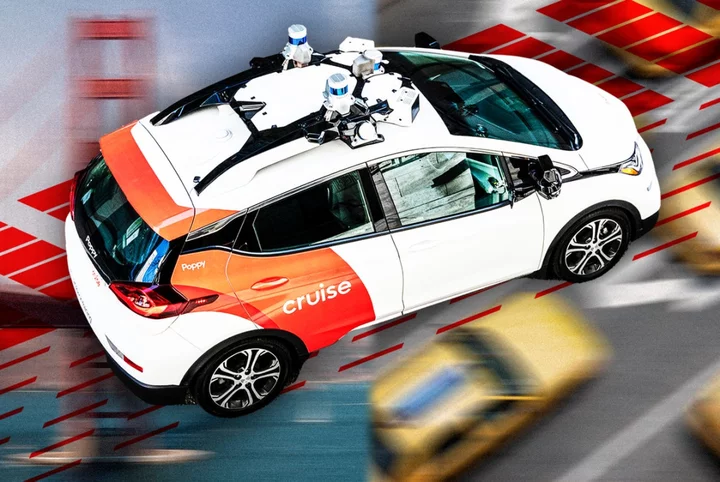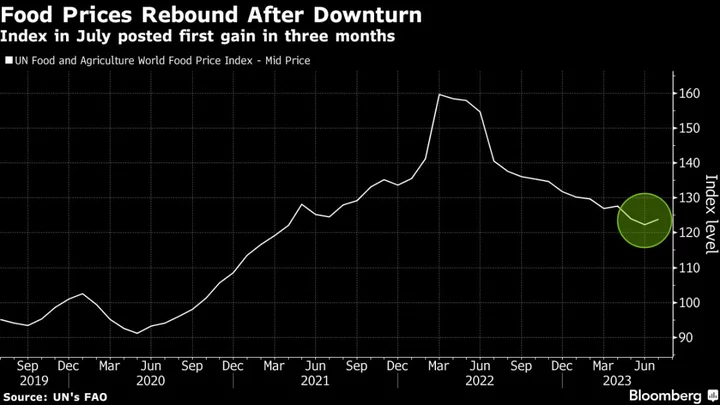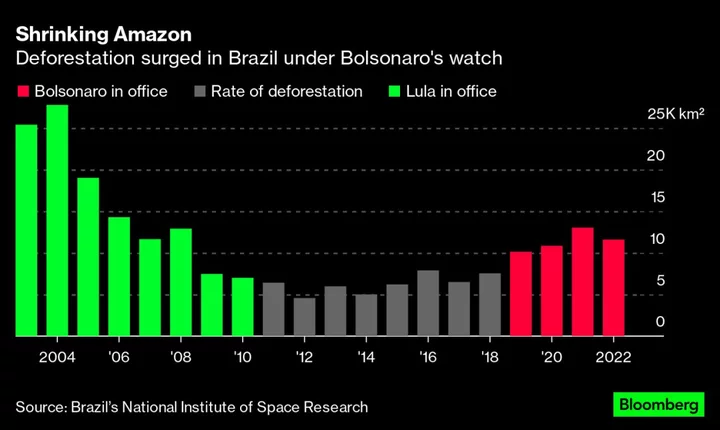
Activists Sue South Africa’s Environment Authorities Over Arcelor Pollution
South Africa’s environment minister and the national air quality officer have been sued by environmental activists for allegedly
2023-08-16 00:49

MTN’s Fintech Unit Seeks More Investors After Mastercard Deal
MTN Group Ltd. is seeking as many as three more strategic investors in addition to Mastercard Inc. for
2023-08-15 20:58

Texas woman awarded $1.2bn after ex-boyfriend posted revenge porn online
A Texas woman has been awarded more than one billion dollars after explicit images of her body were shared on porn websites by her former partner. Attorneys for the woman, who is only identified in court documents as Jane Doe, told ABC News that the $1.2bn award was more than what they were expecting. The woman filed her civil lawsuit in Harris County Civil Court in April 2022, alleging that her ex-boyfriend Marques Jamal Jackson had shared her nudes on fake Twitter, Facebook and YouTube profiles. The defence also alleged that Mr Jackson, who did not attend the one-day-long civil trial, then forwarded the profiles to the woman’s friends, family, and colleagues. Deliberations before the jury reached an agreement regarding the award sum — the largest civil verdict in the Lone Star State so far this year — only took 30 minutes. Speaking out following the trial, the woman said having pictures of her naked body shared without her permission had left her traumatised. “This type of experience is devastating,” the woman told ABC. “It’s extremely painful. It’s hurtful. It’s embarrassing and you fear that either something will trigger and it will start again or that the previous effort inspired someone new and then they might start.” According to court documents obtained by KHOU 11, the woman and Mr Jackson met in 2016 and went on to have a four-year relationship. When they broke up in 2021, Mr Jackson allegedly shared her nudes on Facebook, Twitter, Dropbox, and Pornhub. The woman’s attorney Jacob Schiffer said that Mr Jackson had access to a camera system installed on her mother’s property as well as her login information for several social media and email accounts. Mr Schiffer said Mr Jackson would even hack into the woman’s Zoom meetings to show her nudes. “Every day was me, wake up, I’m checking, I’m trying to prevent it, I’m trying to constrain it,” the woman recounted to ABC. At one point, her attorney told ABC, Mr Jackson reportedly emailed her: “...won’t change the fact that you will spend the rest of your life trying and failing to wipe yourself off the internet. Everyone you ever meet will hear the story and go looking.” The Independent could not find legal representation listed for Mr Jackson. The victim said that she unsuccessfully asked police for help and after a year of living in fear that more of her pictures would be shared online, she hired legal counsel. Mr Schiffer said that while he doesn’t expect Mr Jackson to pay the money, he hopes the hefty sum sends a message. “For the future, anyone thinking of wanting to do this to somebody else that is going to weigh on them like a ball and chain until the date that they’re buried,” Mr Shiffer said. Sharing intimate material without a person’s consent is considered a felony. It is unclear whether the victim plans to file criminal charges. The Independent has reached out to the woman’s attorneys. Read More Four in 10 women have experienced or witnessed sexual harassment on social media, research has found Thirteen-year-old girl is forced to give birth under Mississippi abortion ban How a law associated with mobsters could be central in possible charges against Trump
2023-08-15 07:16

Sasol Slumps as It Flags Profit Hit From S. Africa Snarl-Ups
Sasol Ltd. shares dropped the most in five months after the fuels and chemicals producer said the poor
2023-08-14 19:24

Bankers Hate Saying ‘ESG’ But Are Hardwiring It Into Their Work
Bankers, money managers and other financial market participants are starting to loathe the label “ESG” — but they’re
2023-08-14 18:20

How a vote to empower autonomous ‘robotaxis’ from Cruise and Waymo has divided San Francisco
The future was waiting outside my door, and it was an electric taxi named Saxophone. On Wednesday, 9 August, on the eve of a much-watched vote to expand the footprint of autonomous vehicles (AV) in San Francisco, I summoned a driverless taxi from the company Cruise for a test drive. The Cruise AVs, which began operating paid, Uber-like on-demand rides in June of 2022, are a frequent sight in my San Francisco neighbourhood, The Richmond. And they’re about to get even more ubiquitous: on Thursday evening, following a marathon seven-hour public comment session, the California Public Utilities Commission (CPUC) voted 3-1 to allow Cruise and Google parent company Alphabet’s Waymo venture to run paid rides, without a safety driver in the cabin, 24/7 on San Francisco streets. Much like the members of the public who turned out in droves to comment on the vote, I have mixed feelings about autonomous vehicles. I’ve been trailed, somewhat ominously, on backstreets by a Cruise AV as I rode my bike, with the robo-driver declining to pass me like most human pilots would. I’ve seen a homeless man approach the window of a robotaxi to ask for change, only to find no one inside, a metaphor of San Francisco inequality a bit too on the nose even for a writer like me. I decided, for the time being, to leave the public debating to the local officials and longtime San Francisco residents and start with the basics: what was it like to ride in one of these things? For a 0.8 mile, one-way ride to the local grocery store, I was charged $8.26, about a dollar per minute of driving time. The ride was smooth, though the Cruise AV would occasionally move in a way that was, while perfectly safe, not quite human, gliding without hesitation within inches of a parked SUV’s bike rack, hesitating ever-so-slightly within the normally smooth arc of a turn, accelerating with an almost imperceptible stutter after it dropped me off. Still, I was lucky. Earlier this month, an NBC reporter taking a test drive was stuck inside a Cruise that mysteriously stalled, then blocked two lanes of traffic as it idled at a 45 degree angle against the median. After I got home, driven by “Flora,” I looked it up and the price of my roundtrip was virtually identical to that of an Uber. I sat there thinking about the strange economics of 2023 San Francisco, where the product of billions of dollars of investment had delivered a service that was both an incredible technical leap, the stuff of the Jetsons, that also offered me no financial advantage, snatched a job from a rideshare driver, and took me on a round trip that would’ve been 15 minutes faster – and free – on a rusty old bike. The future had arrived, but was it one that I, or San Francisco, really wanted, let alone needed? Wednesday’s vote exposed how deeply divisive such technologies are in San Francisco, and the thorny considerations inherent in any attempt to carry out large-scale changes to the transit system. Human drivers are unsafe death machines themselves, killing thousands of people each year. And the need for green mass transit has never been higher. But are autonomous vehicles the best solution? The companies, at least, celebrated the decision as heralding a moment of great progress. “Offering a commercial, 24/7 driverless ridehail service across San Francisco is a historic industry milestone – putting Cruise in a position to compete with traditional ridehail, and challenge an unsafe, inaccessible transportation status quo,” Prashanthi Raman of Cruise said in a statement to The Independent. It was indeed major victory for the industry, though regulators warn there’s still much work to be done before autonomous vehicles flood the roads. “The conversation on how best to integrate AVs into our community is far from over,” said CPUC president Alice Busching Reynolds, who voted for the expansion. One commissioner, Genevieve Shiroma, wasn’t yet convinced, and argued the industry hasn’t given good enough data and has been too quick to brush off reports of driverless vehicles behaving strangely around first responders. “Imagine if one of those so-called anecdotes involved a member of your family in need of urgent medical attention, or was trapped in a burning building,” she said, adding, “All it takes is one real-life example.” Outside of the Public Utilities Commission building, protesters rallied and drew messages like ‘people not profits’ in chalk on the sidewalk, as AV company employees showed out in matching t-shirts. Inside, commissioners heard a mosaic of different opinions. “We are in desperate need of people coming to San Francisco,” Matthew Sutter, who has been driving a taxi cab for 31 years, told the commission. “You’re going to take away jobs with this thing.” Meanwhile, a man named Michael Martinez said expanding Cruise and Waymo’s footprint in San Francisco would mean the city, already one of the most expensive and unequal places to live in America, was “pimped out by yet another couple of large tech companies so that all their employees here wearing yellow shirts might get to cash out their stock options.” Numerous advocates pointed out how driverless cars could discriminate against disabled people, given that they sometimes drop people a few doors down from their chosen destination, and they don’t have drivers who are able to help people with wheelchairs or other mobility aides enter and exit a vehicle. A taxi driver can help someone carry their groceries to a front door, but an AV can only go from place to place. Others argued the technologies would in fact help disabled people, overcoming the “last mile problem” of public transit, when passengers aren’t able to get all the way to their destination, and that AVs would limit dangerous human errors like distracted driving. “Too often, patients don’t make it to my operating room because they have been killed by distracted drivers or road rage,” an orthopedic surgeon testified. A representative for Mothers Against Drunk Driving said Cruise and Waymo could be a “pillar” of stopping the “100 per cent preventable crimes” of drunk driving deaths. Robotaxis began operating paid taxi services in San Francisco in June of 2022, and since then, hundreds of Cruise and Waymo vehicles have filled the streets. The city, synonymous with Silicon Valley technology and innovation, is seen as the most important test yet of AV technology, a high-profile audition for a future of mass, autonomous transit. “Operating robotaxis in SF has become a litmus test for business viability,” Cruise CEO Kyle Vogt wrote on X in April. “If it can work here, there’s little doubt it can work just about everywhere.” So far, the experience has been mixed, with a fleet of up to 400 autonomous taxis carrying out thousands of successful rides – and enraging some local residents and city officials, who say the robotaxis carry out bizarre and unsafe behaviour on a regular basis with little accountability. On 21 January, San Francisco firefighters were battling a blaze on Hayes Street when they saw a driverless taxi from Cruise gliding towards them. The Cruise vehicle, a modified electric Chevrolet Bolt, was heading straight for their hoses. The firefighters made attempts to stop the vehicle, but couldn’t. First responders were only able to halt the car once they shattered its window, according to a letter from city officials. Local transit activists say Cruise and Waymo vehicles can be seen creeping creepily towards pedestrians on sidewalks, blocking buses, and getting in the way of first responders. “I’ve seen them not totally stop at a stop sign,” an activist with the local transit group Safe Street Rebel, who asked to remain anonymous, told The Independent. “I’ve seen them get too close to pedestrians. I personally have felt very unsafe crossing the road whenever there is one stopped. I see them stalled on the streets, too. I just saw that the other day one stalled, blocking an emergency vehicle. This is something that they just do on their own.” The group has carried “cone-ing” protests, placing traffic cones on top of empty AVs to temporarily stall them. According to data Cruise shared with CPUC earlier this week, between January and mid-July of 2023, Cruise AVs temporarily malfunctioned or shut down 177 times and required recovery, 26 of which such incidents occurred with a passenger inside, while Waymo recorded 58 such events in a similar time frame. Meanwhile, according to the San Francisco Municipal Transit Agency (SFMTA), between April 2022 and April 2023, Cruise and Waymo vehicles have been involved in over 300 incidents of irregular driving including unexpected stops and collisions, while the San Francisco Fire Department says AVs have interfered 55 times in their work in 2023. Last year, Cruise lost contact with its entire fleet for 20 minutes according to internal documentation viewed by WIRED, and an anonymous employee warned California regulators that year the company loses touch with its vehicles “with regularity.” (The company said at the time Cruise cabs have “fallback” systems directing them to turn on their hazard lights and pull over in the face of such problems.) Since being rolled out in San Francisco, robotaxis have killed a dog, caused a mile-long traffic jam during rush hour, blocked a traffic lane as officials responded to a shooting, and driven over fire hoses. Jeffrey Tumlin, San Francisco’s director of transportation, has called the rollout of robotaxis a “race to the bottom,” arguing Cruise and Waymo weren’t yet definitive transit solutions, and instead had only “met the requirements for a learner’s permit.” "The biggest concern is that someone is going to get really severely injured or killed because we cannot properly respond to an incident," San Francisco fire chief Jeanine Nicholson said in June. "Or if they can get in the way at an incident. We’ve really gotten lucky so far, but it’s only a matter of time before something really, really catastrophic happens." “We have 160,000 calls a year. We don’t have the time to personally take care of a car that’s in the way when we’re on the way to an emergency,” she added. Others worry the AV technology will cause another shock to workers in the city, displacing more transit jobs that were already turned upside-down or eliminated with the arrival of Uber and Lyft. “We’re already seeing it,” Jose Gazo, an Uber driver, told The San Francisco Standard in July. “With business going like this, we’re going to go homeless.” Not that taxis were a particularly worker-friendly technology in San Francisco, either. In 2010, the city began auctioning off driver medallions for $250,000 a piece. Declining taxi revenues, combined with a sky high cost of living, has left many San Francisco taxi drivers barely making survival wages in order to pay off debts on their cabs, even as the future of this investment looks increasingly doubtful. The autonomous vehicle companies insist that human drivers are the real risk. Car crashes are a leading cause of death in the US, according to the CDC, and Cruise and Waymo point to the fact that their AVs haven’t been involved in a single fatal accident in San Francisco. (Such deaths have occured in the US, though; an Uber self-driving vehicle with a backup driver was involved in a 2018 accident in Arizona that killed a pedestrian.) “Autonomous vehicles don’t get drunk or drowsy. They don’t text at the wheel,” Waymo co-CEO Tekedra Mawakana wrote in a July column in the San Francisco Chronicle. “We want our vehicles to improve road safety and to contribute to the city’s economic recovery and its Vision Zero goal of no street fatalities.” However, unlike their fleshy, distractable human cousins, police cannot cite autonomously driven cars for common moving violations like reckless driving or speeding. “The data to date indicates the Waymo Driver is reducing traffic injuries and fatalities in the places where we operate,” the company told The Independent in a statement. “In particular, in a million miles of fully autonomous operations, we had no collisions involving pedestrians or cyclists, and every vehicle-to-vehicle collision involved rule violations or dangerous behavior on the part of the human drivers.” “2022 was the worst year for traffic deaths in San Francisco in nearly a decade,” it added. “Waymo’s mission is to improve road safety and mobility for everyone.” Some city officials, meanwhile, say the companies are attempting to sell a safety record that hasn’t been fully open to public scrutiny, with the companies allegedly declining to share full data or giving city officials redacted reports. “Given that we do not have actual data, what we have is information from reports that have been made by members of the public, by city employees, by firefighters, by transit operators,” Julia Friedlander, senior manager of automated driving policy at the SFMTA, said at a Monday CPUC meeting. “And what we have seen is that things are not getting better. The monthly rate of incidents has been growing significantly over the course of 2023. You’ll see that June was the month with the highest number of incidents of all kinds.” The companies also argue AVs are a green solution. Cruise wrote in a 2022 blog post that “of the nearly 900,000 autonomous miles Cruise drove in 2021, not one added to CO2 emissions, and all were powered by 100% renewable energy.” Some, however, are sceptical of this claim, noting that any transit method that encourages individual car use over low-cost, mass public transit is inherently inferior. “This just adds more cars onto the road. It diverts our attention and financial investment and even legislative action to invest in public transit. It puts more cars on the road,” the Safe Street Rebel activist told The Independent. “We’re big fans of technology that actually benefits people,” she added. “Trying to graft unreliable technology onto a wasteful, dangerous, inefficient mode of transport is hardly looking to the future.” Read More Is this $6.6 billion flying car startup the future of green transit, or just another rich guy fantasy? Recalling a wild ride with a robotaxi named Peaches as regulators mull San Francisco expansion plan Waymo self-driving car kills a dog in San Francisco Summer camp in California gives Jewish children of color a haven to be different together Investigators say miscommunication between pilots caused United plane to drop near ocean's surface 2 robotaxi services seeking to bypass safety concerns and expand in San Francisco face pivotal vote
2023-08-12 04:27

U.S. forecasters raise number of major hurricanes for 2023
By Erwin Seba HOUSTON (Reuters) -U.S. government forecasters on Thursday expect a more dangerous Atlantic storm season this year, raising
2023-08-10 23:56

World’s Top Food Producers Push Back on EU Deforestation Rules
The world’s largest agriculture producers are pushing back against new European Union rules that require proof that crops
2023-08-09 23:28

South Africa’s $8.5 Billion Climate Pact Hit by Further Delays
South Africa’s government will need another two to three months to complete an energy transition implementation plan, further
2023-08-08 18:22

Lula Enlists Neighbors Into Brazil’s Battle to Save the Amazon
The leaders of South America’s Amazon nations will gather in Brazil this week as President Luiz Inacio Lula
2023-08-08 17:28

DeSantis once again defends slavery curriculum: Enslaved people ‘showing resourcefulness’ developed ‘skills’
Ron DeSantis continues to defend newly approved curriculum guidelines in Florida instructing students to learn that enslaved people “developed skills” that could be “applied for personal benefit”. “That means they developed skills in spite of slavery, not because of slavery,” the governor told NBC News in a recent interview that aired on 7 August. “It was them showing resourcefulness and then using those skills once slavery ended,” he added. Mr DeSantis, who is seeking the Republican nomination for president in 2024, has dismissed criticism from Vice President Kamala Harris and Democratic and Republican members of Congress urging Florida officials to amend the state’s African American history standards and reflect an honest history of race and racism in school curricula. The vice president has also rejected an invitation from Mr DeSantis to “discuss” the standards, telling a crowd in Orlando earlier this month that “there is no roundtable, no lecture, no invitation we will accept to debate an undeniable fact: there were no redeeming qualities of slavery.” Mr DeSantis had previously stated he “wasn’t involved” with the guidelines approved by the state’s appointed Board of Education. He said the standards are “probably going to show some of the folks” – enslaved people – “that eventually parlayed, you know, being a blacksmith into doing things later in life.” The development of such “skills” would not have benefited the millions of enslaved people in the US in the decades before slavery’s abolition. Another controversial guideline instructs high schoolers to be taught that a massacre in the state led by white supremacists against Black residents to stop them from voting in 1920 included “acts of violence perpetrated against and by African Americans.” “Adults know what slavery really was. It involved rape, it involved torture, it involved taking a baby from their mother, it involved some of the worst examples of depriving humanity of people in our world,” Ms Harris said in her remarks in Jacksonville last month. South Carolina Senator Tim Scott, the only Black Republican in the Senate, echoed Ms Harris in his criticism of the standards, stressing that slavery was defined by “separating families, about mutilating humans and even raping their wives”. “It was just devastating,” said Mr Scott, who is also seeking the 2024 Republican nomination. “So I would hope that every person in our country – and certainly running for president – would appreciate that.” Mr DeSantis told NBC in response: “Don’t take that side of Kamala Harris against the state of Florida. Don’t indulge those lies.” The new standards join the governor’s overhaul of public education and a “parents’ rights” agenda that targets honest lessons on race and racism and gender and sexuality, which the governor told NBC amounts to “indoctrination”. “Those standards were not political at all,” he added. “The legislature didn’t dictate any of that. [The] governor’s office didn’t dictate anything of that.” Last week, before thousands of high school students enrolled in advanced placement courses begin classes for the 2023-2024 school year, the DeSantis administration criticised the College Board’s warning that Florida education officials had “effectively banned” AP Psychology courses in the state under the Parental Rights in Education Act, what opponents have derided as the “Don’t Say Gay” law. Read More Ron DeSantis admits ‘of course’ Donald Trump lost the election DeSantis blasted for ‘un-American’ restrictions on AP psychology course under ‘Don’t Say Gay’ law Why Florida’s new curriculum on slavery is becoming a political headache for Ron DeSantis
2023-08-07 22:46

A Nation Shuts Off the Internet, and Power Goes Out to Homes
For years, governments around the world have assailed social media for their role in the spread of disinformation,
2023-08-05 12:29
